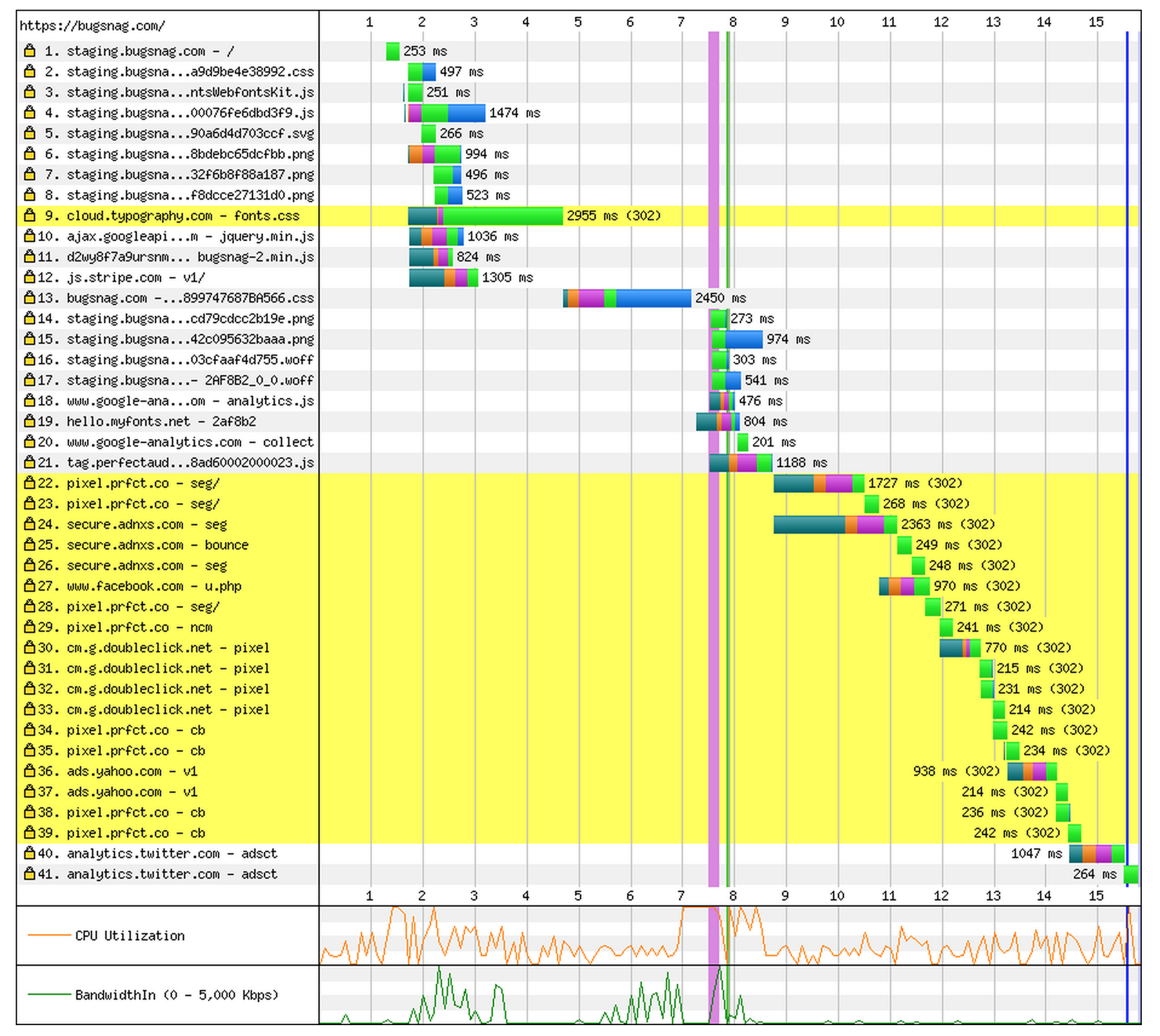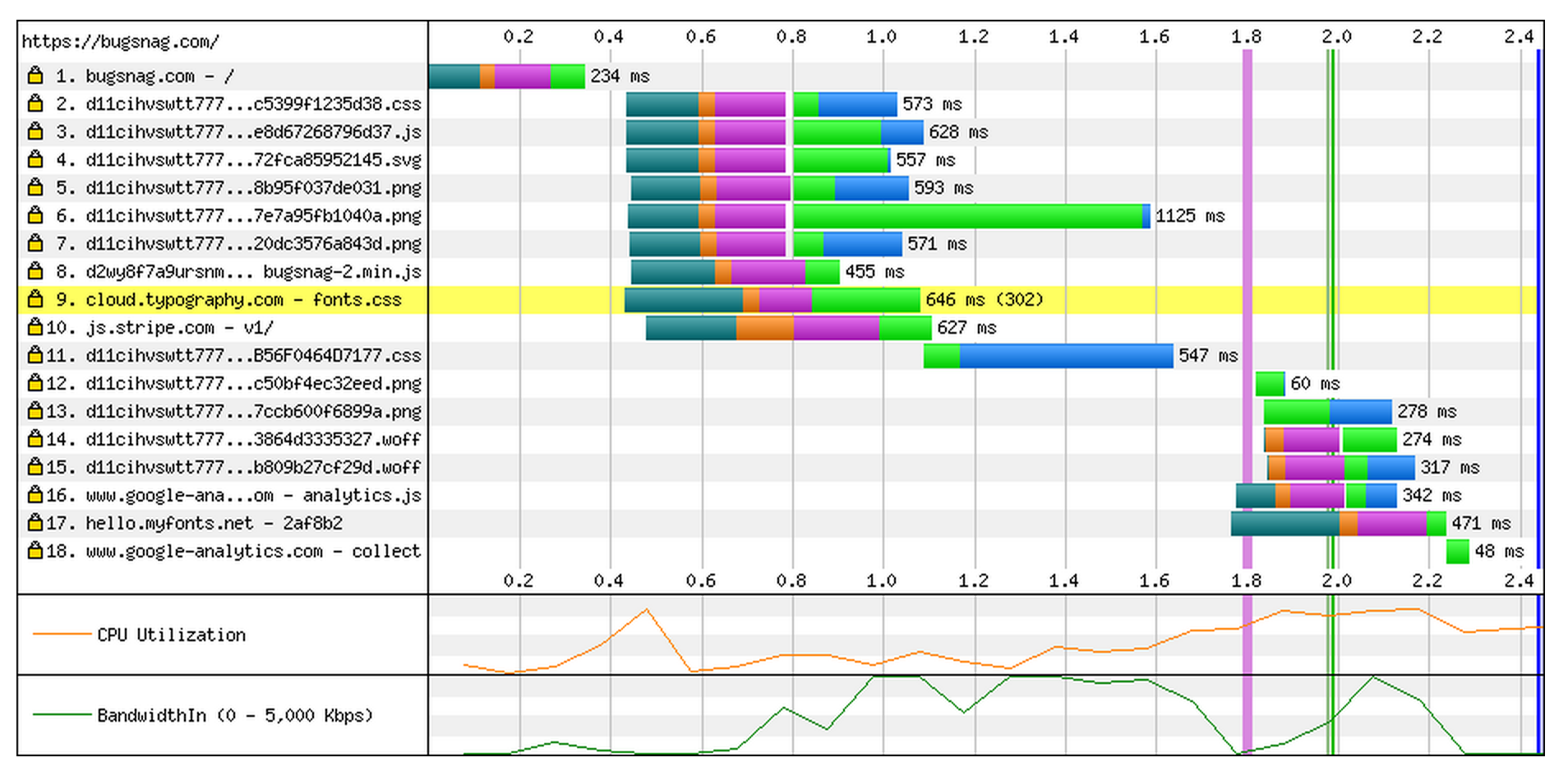Tips for improving website performance
At Bugsnag, one of the things we pride ourselves on is speed. Usually crashes appear on your dashboard within a second of occurring (and that includes the few hundred milliseconds it takes your app to connect to our servers over SSL and report the crash).
At the beginning of October we began to notice that while errors were showing up in the dashboard quickly, loading the dashboard in a web-browser was taking a significant amount of time. We had one report from a user in New Zealand where it took 8 seconds to load the login screen.
Clearly something had to be done, and over the last week or so I’ve sped up the site by a factor of 2 to 4, depending on where you’re connecting from. This post will share some of the techniques I used.
1. Measure the performance
There’re lots of amazing tools out there for analyzing web performance. All web browsers include a network timeline in their developer tools, and WebPageTest by Google lets you capture this information from all around the world. This is a particularly bad example from New Zealand:

The time I care most about is time until DOMContentLoaded has run (the purple line at 7.5s), since that’s the point the user can interact with Bugsnag. The remaining requests are for analytics purposes.
If you want advice on how to improve this, then both YSlow and PageSpeed are useful. They’ll tell you which requests are causing the most problems, and point out quick fixes.
2. Use a CDN for assets
A CDN removes latency by moving cacheable assets closer to your users. This matters particularly if you’re serving assets over https, as setting up connections is slower. We’re hosted on Amazon EC2, so we configured CloudFront to sit in front of our assets.
CloudFront acts as a transparent proxy, so this didn’t require any change to how we deploy; CloudFront just requests the assets from bugsnag.com and then caches them. If it receives a request that isn’t an asset, it redirects back to the home page.
3. Set long cache headers
We’re using Rails, so every time an asset changes, its URL changes. This means we can just set up a blanket rule that everything in /assets/ can be cached forever. The exact nginx configuration we’re using is:
location ~ ^/(assets|fonts)/ {
# also sets Cache-Control: max-age=3153600
expires 1y;
add_header Cache-Control public;
# set by cloudfront
add_header Last-Modified "";
add_header ETag "";
# Allows debugging script tags on a CDN
# https://www.bugsnag.com/docs/notifiers/js/cors
add_header Access-Control-Allow-Origin "*";
}
4. Delete unused code
We had a few scripts we didn’t need anymore, and some of these actually included more script tags asynchronously. Deleting those helped significantly both with time until DOMContentLoaded, and with time until the load event fired.
5. Minifying assets
When we’d upgraded to Rails 4, we didn’t spot the memo that the API to enable JavaScript minification had changed. Re-enabling that helped, as did compressing the big PNG image by 90% using ImageOptim and ImageAlpha.
We also started bundling jQuery with our assets instead of using the one from Google’s CDN. This avoided an extra connection, and since connection latency is highly variable, the fewer connections you’re making, the less variable your page load time will be.
Finally, we enabled gzip compression on our JavaScript, CSS and SVG files at the nginx level. CloudFront won’t gzip assets for you, but if you serve assets that’ve been gzipped, it’ll cache them like that.
The results

With all of this in place, we reduced the cold load time from around 7.5s down to 1.8s! The benefit was even greater though because now most assets don’t need to be re-downloaded. Whereas before every page load took almost 7.5s, now subsequent page loads take closer to 900ms.
There’s still room to improve. In the future I want to play with using an SSL accelerator, possibly coupled with SPDY to improve connection times. We also need to optimize the amount of JavaScript and CSS we load to improve download times. And once that’s done, I’m sure there are some quick wins in terms of rendering pages more quickly from Ruby.
If you have any tips for performance, please let me know on Twitter. Otherwise, to use the fastest exception notification service around sign up for Bugsnag in a flash.